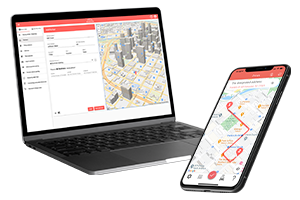Last updated: April 12, 2024
Embarking on the journey of self-employment is an exhilarating chapter in anyone’s career, offering unparalleled freedom to pursue one’s passions and dreams. Yet, with this freedom comes the responsibility of navigating the complexities of self-employment taxes—a daunting task for many. Understanding the intricacies of tax obligations, deductions, and strategies to maximize savings is crucial for financial success and sustainability.
In this comprehensive guide, we delve into the essential aspects of self-employment taxes, providing a clear roadmap for entrepreneurs, freelancers, and independent contractors.
From understanding the fundamentals of self-employment taxes, calculating what you owe, maximizing deductions, to filing and paying taxes efficiently, we’ve got you covered. Additionally, we introduce MileageWise, an innovative tool designed to streamline tax calculations, particularly for those looking to leverage mileage deductions to their advantage.

Understanding Self-Employment Taxes: A Friendly Guide
Embarking on the self-employment journey is thrilling, but with great freedom comes great responsibility—specifically, understanding and managing your self-employment taxes. Let’s break it down together, shall we?
What Exactly Are Self-Employment Taxes?
In essence, self-employment taxes cover Social Security and Medicare, two pillars of your future financial security. Unlike traditional employees, whose employers handle half of these contributions, self-employed folks carry the full load on their shoulders. But don’t worry, it’s not as daunting as it sounds!
- Social Security: This is your future safety net, offering benefits for retirement, disability, and survivors. It’s like a promise that your hard work today supports your well-being tomorrow.
- Medicare: This ensures you have medical coverage once you hit retirement age. Think of it as investing in your future health and peace of mind.
Who Needs to Pay Self-Employment Taxes?
If you’ve earned $400 or more from self-employment, congratulations on your success, and welcome to the world of self-employment taxes! This applies to freelancers, independent contractors, and small business owners alike. Basically, if you’re your own boss, this is for you.
FAQs to Keep You Informed and Engaged
- Q: How much will I have to pay?
- A: The magic number is 15.3% of your net earnings, which includes 12.4% for Social Security and 2.9% for Medicare.
- Q: Can I deduct any of this on my taxes?
- A: Absolutely! You can deduct the employer-equivalent portion (roughly 50%) of your self-employment tax when calculating your adjusted gross income.
- Q: When do I need to pay these taxes?
- A: Unlike traditional employees, you’ll make estimated tax payments quarterly. It’s like a subscription to your future self’s well-being!
Tips and Tricks
- Stay Organized: Keep meticulous records of your income and expenses. It’ll make calculation time less of a headache.
- Use Technology: Leveraging accounting software can be a game-changer for managing your finances and taxes.
- Seek Professional Help: When in doubt, consult with a tax professional. They’re like navigators in the vast sea of tax laws and regulations.
Navigating Self-Employment Tax Rates: Your Handy Guide
Hello, self-made mavens and freelance wizards! Today, we’re diving into the riveting world of Self-Employment Tax Rates. Yes, it sounds as serious as deciding on your next Netflix binge, but stick with me—it’s crucial for ensuring your financial health and avoiding surprises during tax season. Let’s decode the mysteries of tax rates together in a way that’s as engaging as your entrepreneurial spirit!
What’s the Deal with Self-Employment Tax Rates?
At the heart of self-employment taxes are two key components: Social Security and Medicare. These are the safety nets that catch us when we leap into the great unknown of retirement and healthcare needs. The self-employment tax rate is a total of 15.3%, split into 12.4% for Social Security and 2.9% for Medicare. Think of it as your contribution to future-you’s peace of mind and health.
Breaking Down the Rates
- Social Security: This is the bigger chunk at 12.4%. It funds your future retirement benefits, disability benefits, survivor benefits, and even benefits for your dependents. It’s like investing in a safety net woven from your hard work.
- Medicare: At 2.9%, this part goes toward your healthcare in retirement. It’s ensuring that future-you can navigate health concerns with one less worry.
FAQs to Fuel Your Financial Savvy
- Q: Who needs to pay self-employment taxes?
- A: If you’ve earned more than $400 from self-employment, congratulations! You’ve also earned the privilege of contributing to self-employment taxes.
- Q: How do income thresholds affect my self-employment taxes?
- A: For Social Security, only the first $168,600 of your net earnings are taxed. Anything above that is free from Social Security tax but still subject to Medicare tax. For those particularly successful years, it’s a little financial silver lining.
- Q: Is there an additional Medicare tax?
- A: Indeed, there is. If your earnings surpass certain thresholds ($200,000 for single filers or $250,000 for joint filers), you’ll pay an additional 0.9% on top of the standard Medicare rate. It’s the price of success, and it goes towards maintaining the healthcare system that supports us all.
Cracking the Code on Calculating Self-Employment Tax
Hey there, entrepreneurial superstars! Ready to tackle the thrilling world of calculating self-employment tax? Fear not, for this journey through numbers is not only essential but can be as engaging as planning your next big project. Let’s dive into the nuts and bolts of making sense of what you owe, ensuring you keep as much of your hard-earned money as legally possible. Buckle up, and let’s break it down!
The Basics of Self-Employment Tax Calculation
Calculating your self-employment tax is like following a recipe for your favorite dish—there are specific ingredients (or numbers) and steps you need to follow:
- Determine Your Net Earnings: Start with figuring out your net earnings from self-employment. This means subtracting your business expenses from your gross income. It’s the foundation of your tax calculation, akin to prepping your ingredients before you start cooking.
- Understand the Tax Rate: Remember, the self-employment tax rate stands at 15.3%, combining 12.4% for Social Security and 2.9% for Medicare. Just like in baking, getting the proportions right is crucial.
- Calculate the Taxable Portion: Not all your net earnings might be subject to the full tax rate. Generally, 92.35% of your net earnings from self-employment is what’s taxable. It’s a specific measurement, much like ensuring you have the right amount of flour for your cake.
FAQs to Guide Your Way
- Q: How do I know if I need to pay self-employment tax?
- A: If your net earnings from self-employment exceed $400, it’s time to contribute to the self-employment tax pot.
- Q: Can I deduct any portion of my self-employment tax?
- A: Absolutely! You can deduct the employer-equivalent portion of your self-employment tax when calculating your adjusted gross income. This equates to roughly 50% of what you pay.
- Q: What forms do I use to calculate and report my self-employment tax?
- A: You’ll use Schedule C to report your income and expenses and calculate your net earnings. Then, Schedule SE will help you figure out the actual self-employment tax owed.
Mastering the Art of Filing and Paying Self-Employment Taxes
Now let’s demystify the process of filing and paying self-employment taxes. Think of it as the final boss in your entrepreneurial video game – daunting, sure, but utterly satisfying once you know the tricks to defeat it. Let’s equip you with the knowledge and tools you need to navigate this landscape like a pro.
The Checklist: Filing and Paying Made Easy
- Know Your Deadlines: Mark your calendar for April 15th (or the next business day if it falls on a weekend or holiday) for your annual tax return, and don’t forget the quarterly estimated tax payments due April 15th, June 15th, September 15th, and January 15th.
- Gather Your Documents: Before you dive in, make sure you have all your financial statements, receipts, and any forms like 1099-NEC if you’ve received them from clients.
- Use Schedule C and Schedule SE: Schedule C helps you report your income and expenses to calculate your net profit, while Schedule SE is used to figure out the self-employment tax owed.
FAQs
- Q: How do I actually pay my self-employment taxes?
- A: You can pay online through the IRS Direct Pay system, by phone, or via mail. For the tech-savvy, the Electronic Federal Tax Payment System (EFTPS) is also a great option.
- Q: What if I can’t pay all at once?
- A: Fear not! The IRS offers payment plans. You can apply for an installment agreement online, breaking down your tax debt into more manageable monthly payments.
- Q: Can I deduct my home office expenses?
- A: Yes, if you use part of your home regularly and exclusively for business, you may be eligible to deduct expenses like mortgage interest, insurance, utilities, repairs, and depreciation.
Embracing the Process
While filing and paying taxes might seem like a chore, embracing it as part of your business routine can actually offer peace of mind and financial clarity. Remember, paying your self-employment taxes is not just about contributing to Social Security and Medicare; it’s about investing in your future.
Tools and Resources
Make use of digital tools and resources like the IRS website, tax software, or even a trusted tax professional to guide you through the process. These resources can provide personalized advice and ensure that you’re taking advantage of all possible deductions and credits.
How MileageWise Can Revolutionize Self-Employment Taxes

In the bustling world of self-employment, managing taxes efficiently is akin to steering your entrepreneurial ship through calm waters. MileageWise emerges as a beacon of guidance, especially when navigating the often-overlooked aspect of deducting business mileage. Let’s explore how this innovative app can transform the way self-employed professionals approach their taxes, utilizing keywords to highlight its benefits.
Comprehensive Mileage Tracking
At the heart of MileageWise is its ability to meticulously track business mileage, a critical component for anyone looking to maximize deductions on their self-employment taxes. Whether you’re a self-employed delivery driver calculating your routes or a consultant visiting clients, or a small business owner looking to keep track of their mileage for the self employed, logging your miles in an IRS-Proof way is essential. With features designed to capture/retrieve every trip both ongoing and retrospectively, MileageWise ensures that self-employed individuals can claim the maximum deduction for mileage expenses.
Effortless Tax Estimation and Calculations
For those daunted by the prospect of calculating taxes, MileageWise offers a solution. Its integration with self-employed tax calculators and self-employed tax estimators streamlines the process of determining how much to set aside for taxes. By incorporating data on business mileage, the app helps generate more accurate tax estimates, ensuring that self-employed professionals are well-prepared for quarterly taxes and annual filings.
Maximizing Deductions
Understanding what counts as business mileage can be complex. MileageWise simplifies this by offering insights into what qualifies, from average miles per year for self-employed individuals to specific scenarios like selling a company vehicle to oneself. This clarity ensures users don’t miss out on valuable deductions, potentially lowering their taxable income and saving money.
Tools for Every State
Given the variance in state self-employment taxes, MileageWise’s adaptability is invaluable. Whether you need a self-employed tax calculator for California, Texas, or Florida, the app’s tailored calculations consider state-specific guidelines, ensuring accurate tax estimations for both federal and state taxes.
Simplifying Record-Keeping
For self-employed individuals who have never filed taxes or are looking for a more organized approach, MileageWise offers a seamless solution. Its self-employed mileage spreadsheet template provides a structured way to keep track of business mileage. If users prefer the more convenient way, they can just let MileageWise run in the background and produce impeccable mileage logs that fulfill all IRS-requirements.
Integration and Accessibility
With features like a seamless Freshbooks integration, MileageWise encourages users to integrate their mileage tracking with broader financial management tools. This integration simplifies the tax preparation process, ensuring that self-employed professionals have a comprehensive overview of their financial situation.
In conclusion, MileageWise stands out as an essential tool for self-employed individuals aiming to navigate the complexities of self-employment taxes with confidence. From mileage tracking to tax estimation and maximizing deductions, it offers a holistic approach to managing business expenses. By leveraging MileageWise, entrepreneurs and freelancers can ensure they’re making informed decisions, ultimately saving time and money while complying with tax regulations.
Wrapping Up
As we wrap up this extensive exploration into the realm of self-employment taxes, it’s clear that while the journey may seem fraught with complexities, the path to mastering them is well within reach.
By breaking down the components—from understanding the basics, navigating calculations, leveraging deductions, to efficient filing and payment strategies—we’ve equipped you with the tools necessary for financial success.
Download MileageWise’s automatic mileage tracker app from Google Play or the App Store & try it for free for 14 days. No credit card required!



